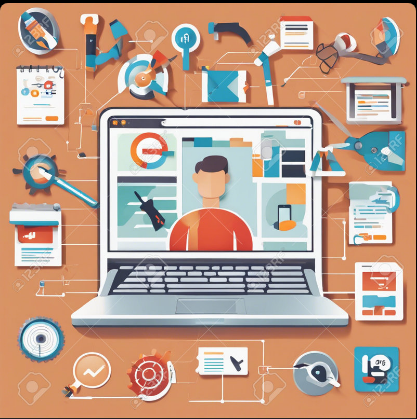Are you looking for ways to make your digital marketing efforts successful? Look no further! This article will provide you with 10 essential steps you can take to ensure success in your digital marketing campaigns. From creating a detailed plan to tracking the results of your campaigns, these steps will help you maximize your marketing efforts and reach your goals.
What are the 10 Essential Steps for Digital Marketing Success?
Digital marketing has become an essential part of any business’s success. With the right strategy, you can reach a wider audience, increase brand awareness, and generate more leads and sales. To help you achieve success, here are 10 essential steps for digital marketing success.
1. Define Your Goals: Before you start any digital marketing campaign, it’s important to define your goals. What do you want to achieve with your campaign? Do you want to increase website traffic, generate leads, or boost sales? Having a clear goal will help you create a plan and measure your success.
2. Research Your Target Audience: You need to understand who your target audience is and what their needs and pain points are. Conducting market research will help you create content that resonates with your target audience and helps them convert.
3. Create Content: Content is king when it comes to digital marketing. It’s important to create high-quality content that is relevant to your target audience. This could include blogs, videos, e-books, podcasts, and more.
4. Select the Right Channels: You need to choose the right channels to reach your target audience. This could include social media networks, search engines, email, and more.
5. Optimize Your Website: Make sure your website is optimized for search engines and mobile devices. This will ensure that your website is easy to find and navigate, and that your content is visible to your target audience.
6. Leverage SEO: Utilizing SEO is key to increasing website visibility. Make sure that your website is optimized for relevant keywords and that your content is optimized for SEO.
7. Use Paid Advertising: Paid advertising is a great way to reach a wider audience and generate more leads and sales. It’s important to understand how different channels work and which ones are most effective for your business.
8. Analyze Your Results: It’s important to track and measure your results so that you can see what’s working and what’s not. Analyzing your results will help you make adjustments and optimize your campaigns.
9. Engage with Your Audience: Engaging with your audience is a great way to build relationships and increase brand loyalty. You can engage with your audience through social media, email, and other digital channels.
10. Adjust Your Strategy: You need to be prepared to make adjustments to your digital marketing strategy as needed. This could include creating new content, leveraging different channels, and optimizing your campaigns.
By following these 10 essential steps for digital marketing success, you can create a plan that will help you reach your goals and increase your business’s success.
Step 1: Research and Understand Your Target Audience
If you’re looking to achieve digital marketing success, the first step is to know your audience. Understanding your target audience is essential to crafting a successful digital marketing strategy. It’s important to research your target audience’s demographics, interests, and preferences in order to create content that resonates with them. Taking the time to research and understand your target audience will help you create content that is more effective, and will help you reach your digital marketing goals.
When researching your target audience, consider the following: age, gender, location, buying habits, interests, and needs. Knowing these things will help you tailor your digital marketing efforts to target specific audiences and create content that appeals to them. You can also use analytics tools to track the effectiveness of your digital marketing efforts and see which content resonates best with your target audience.
By taking the time to research and understand your target audience, you can create content that is more effective and will help you achieve digital marketing success. Knowing your target audience will also enable you to create content that resonates with them and will help you reach your digital marketing goals.
Step 2: Create Engaging Content
Creating engaging content is essential for digital marketing success. This is because content is the centerpiece of any successful digital marketing strategy. Content allows you to reach your target audience, build relationships with them, and keep them coming back for more. It is also one of the most effective ways to increase your website’s visibility and generate more leads.
To create engaging content, it’s important to understand your target audience and create content that resonates with them. You should also ensure that your content is informative, entertaining, and useful. Additionally, you should use visuals and multimedia to enhance your content and make it more appealing to viewers. Finally, you should also use SEO tactics to ensure your content is seen by as many people as possible.
By creating engaging content, you can increase your website’s visibility, generate more leads, and ultimately achieve digital marketing success.
Step 3: Optimize Your Website
Step 3 in achieving success in digital marketing is optimizing your website. Optimizing your website can help you reach your digital marketing goals by improving the user experience and helping your website rank organically in search engine results pages (SERPs). There are several ways to optimize your website, including improving page speed, optimizing meta tags, and increasing the quality of your content.
Improving page speed is one of the most important optimizations you can make. A slow-loading website can result in lower search engine rankings, user frustration, and decreased conversions. You can improve your page speed by compressing images, minifying HTML, CSS, and JavaScript, and utilizing a content delivery network (CDN).
Optimizing meta tags is another important optimization that can help your website rank higher in SERPs. Meta tags include the title tag, description tag, and keyword tag. Writing compelling meta tags that accurately describe the content on the page can help search engine crawlers understand what the page is about and rank it accordingly.
Lastly, improving the quality of your content can have a huge impact on organic search engine rankings. Quality content should be informative, well-researched, and engaging. You should also optimize content for keyword phrases to ensure that users can find the content when they search for it.
By following these steps and optimizing your website, you can achieve success in digital marketing.
Step 4: Leverage Social Media
Social media is a powerful tool for digital marketing success. Step 4 of any digital marketing strategy should be to leverage social media. Social media provides a platform for businesses to engage with their target audience and build relationships with potential customers. It is a great way to generate leads, promote products and services, and build brand awareness. As well, social media can be used to monitor trends, measure customer satisfaction, and gain insight into industry news. By utilizing social media, businesses can further their digital marketing success and reach a wider audience.
Step 5: Monitor Your Online Brand
Monitoring your online brand is an important part of any digital marketing strategy. When done correctly, it can help you identify areas for improvement and ensure that your brand is reaching its full potential. By monitoring your online brand, you can keep track of what people are saying about your brand, and use that information to make informed decisions about your digital marketing efforts.
Using analytics tools and social media monitoring will help you to track your brand’s performance and determine if your efforts are paying off. Google Analytics and similar tools can help you to determine which keywords and phrases are working best for your brand, and which ones need improvement. You can also use social media monitoring tools to track mentions of your brand on various platforms, and identify potential influencers who can help to spread the word about your brand.
By monitoring your online brand, you can stay on top of the latest trends and adjust your digital marketing strategy accordingly. This will help you to ensure that your brand is staying relevant in the ever-changing digital landscape. In addition, by monitoring your online brand, you can identify any potential issues before they become a problem, and take steps to address them quickly.
Monitoring your online brand is an essential part of any digital marketing strategy, and it’s important that you stay on top of it. Doing so will help you to ensure that your brand is reaching its full potential and staying relevant in the digital world.
Step 6: Track Your Online Performance
Tracking your online performance is an important step in achieving success with digital marketing. It allows you to measure the effectiveness of your efforts, identify areas for improvement, and adjust your plans as needed. With the right tracking tools, you can measure your website traffic, engagement, and conversions, and learn which strategies are most effective for your business.
By tracking your online performance, you can gain valuable insight into what’s working and what’s not. You can use this data to refine your digital marketing strategy and ensure that you’re able to engage your target audience and drive conversions. With the right tracking tools, you can also gain insights into your competitors’ strategies, allowing you to stay one step ahead of the competition.
Tracking your online performance also helps you identify areas for improvement. By analyzing your results, you can determine which aspects of your digital marketing could be improved and make the necessary changes. With the right tracking tools, you can also monitor the performance of your campaigns over time to ensure that they’re delivering the desired results.
In short, tracking your online performance is an essential part of achieving success with digital marketing. With the right tracking tools, you can gain valuable insights into your campaigns and make the necessary adjustments to ensure that you’re able to engage your target audience and drive conversions.
Step 7: Utilize Email Marketing
Email Marketing is one of the most effective tools for achieving success in digital marketing. It allows marketers to easily reach out to their target audience and build relationships with them. Email marketing allows marketers to send personalized messages directly to their customers, allowing them to build a stronger connection with their customers and increase their sales. By utilizing email marketing, businesses can easily connect with their customers on a more personal level, create loyalty, and increase sales. Email marketing also enables businesses to easily measure the success of their campaigns, allowing them to make adjustments and optimize their campaigns for better results. Email marketing is an essential part of any digital marketing strategy, and is an invaluable tool for businesses to reach their desired results.
Step 8: Make Use of Video Content
Video content is an essential element of Digital Marketing success. Videos can provide a unique and engaging way to promote your business, products and services to customers. It can help to build trust and establish a connection with customers. Videos are also effective in boosting SEO rankings and can be used to target specific audiences. When used correctly, video content can be a great way to drive more traffic to your website and increase conversions. With the right video content strategy, you can reach a wider audience and drive more sales. Make sure to create videos that are informative, entertaining and engaging. Utilizing video content can be a great way to increase customer engagement and build trust with your customers.
Step 9: Take Advantage of Paid Advertising
Paid advertising is an essential part of digital marketing success. It allows businesses to reach a larger audience, build brand recognition, and increase sales. Step 9 of achieving digital marketing success is to take advantage of paid advertising. Paid advertising can be a great way to reach new and potential customers. It can also be used to target specific audiences and increase brand awareness. Paid advertising can include search engine ads, display ads, and sponsored posts. With proper research and planning, businesses can use paid advertising to effectively reach their target audience and increase their ROI.
Step 10: Analyze and Adjust Your Strategies
Analyzing and adjusting your digital marketing strategies is the key to success. After all, you want to ensure that you are getting the most out of your investments in digital marketing. Step 10 of the digital marketing process involves analyzing and adjusting your strategies on a regular basis.
Analyzing your digital marketing strategies involves looking at your data and results. You want to look at your website’s analytics, including page views, unique visitors, and conversions, as well as any other metrics you’ve set up. You’ll also want to look at social media analytics to see how your campaigns are performing.
Once you have analyzed your data, you can adjust your strategies accordingly. You may decide to focus more on certain channels or adjust your targeting criteria. You may also decide to adjust your budget or make changes to your campaigns.
Adjusting your digital marketing strategies is an ongoing process. You should always be looking for ways to improve your campaigns and your results. By regularly analyzing and adjusting your strategies, you’ll be able to ensure that you’re getting the most out of your digital marketing efforts.
Conclusion
The 10 Essential Steps for Digital Marketing Success are a great starting point to ensure your digital marketing efforts are successful. They include setting objectives, creating a marketing plan, utilizing digital channels, optimizing your website, creating content, tracking data, establishing brand awareness, using analytics to measure success, leveraging influencers, and optimizing for mobile. By following these steps, you can ensure that your digital marketing efforts are effective, efficient, and successful. By understanding your audience and leveraging the right tools, you can create an effective digital marketing strategy that will help you reach your goals.












